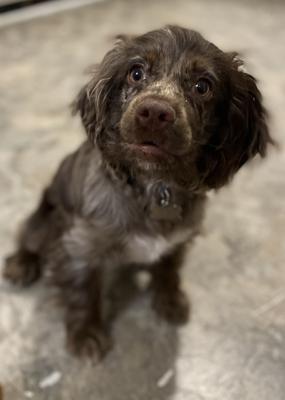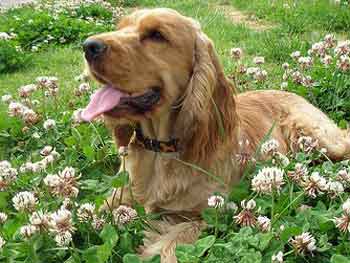- Home
- Cocker Spaniel Information
- Cocker Spaniel characteristics
Endearing Cocker Spaniel Characteristics
Cocker Spaniel characteristics are appealing to everyone because they're so loving and affectionate. However, they can sometimes be sensitive and benefit from good socialization, training, and gentle handling to keep their manners in check.
Learn about the endearing Cocker Spaniel characteristics and discover how adorable this beautiful breed is!
Cocker Spaniel Characteristics: Appearance
Cocker Spaniels are so endearing, with their adoring eyes, long floppy ears, and wagging tails - once you've owned one, you'll never consider any other dog breed!
In my opinion, Cocker Spaniel characteristics are unmatched.
They have such attractive, appealing faces, with beautiful, expressive dark-brown oval eyes (sometimes hazel coloured).
English Cocker Spaniel Characteristics
 My mummy says I'm beautiful!
My mummy says I'm beautiful!Cocker Spaniels are sturdy, compact, and medium-sized, with a deep chest, a short back, and chunky, cat-like paws.
Their skull is domed with a gentle flattening on the top; the muzzle is softly shaped and the same length as the skull.
American Cocker Spaniel Characteristics
Their American cousins look slightly different, mainly in their faces and head.
The difference is quite apparent when you see them together. Just follow the link if you'd like to see some photos and learn more about the American Cocker.
Cocker Spaniel Ears
Cocker's ears are one of their best and most appealing features. Their ears are long, pendulous, set low (lying close to the head) and clad in beautifully soft, flowing fur.
They're so adorable!
Unfortunately, because their ears lie close to the head, it can restrict the airflow around the canal entrance, resulting in increased bacteria and infection. That's why it's essential to keep them clean.
Cocker Spaniel ears may need more attention than other dog breeds; however, it's well worth the extra effort!
I love how their ears swing rhythmically from side to side as they trot about their business.
Unfortunately, another downside to these beautifully pendulous ears is that they often end up in their dinner bowl, but I can live with that!
Cocker Spaniel Characteristics: Their Silky Coat
Their beautiful coat has two layers; a short thick undercoat and a light, silky topcoat, which is flat and straight (but sometimes wavy) and very soft and smooth to the touch.
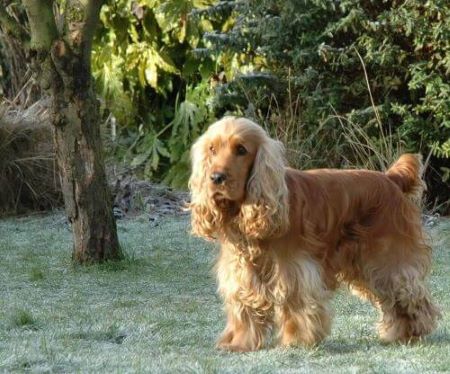 I love my garden!
I love my garden!The photo above is of my little boy (Max) showing typical Cocker Spaniel Characteristics; a long silky topcoat with feathers on his legs, ears, chest and underbelly.
Looking at the length of his coat, it won't be long before it's time for a trip to the groomers!
To say that Spaniels need frequent brushing is probably a bit of an understatement, as their coats can be pretty high maintenance if not looked after properly.
Ideally, Cockers need to be brushed every other day, especially if walked in the countryside; otherwise, you may get away with brushing only a few times a week.
I brush Max every other day but concentrate more on his ears, legs, and paws, especially if I don't have much time.
I may only do his ears one day, but I'll brush and comb through his legs the next day. His underbelly (including under his 'armpits') gets the quick once-over the following day.
Luckily, Max doesn't shed too much; however, I know many Cockers that shed quite a lot, especially black Cockers, whose coats are often thicker.
Generally, roans are pretty good when it comes to shedding.
No matter what colour Cocker you have or how much he sheds, regularly grooming your Spaniel will keep his fabulous coat in tip-top condition!
Cocker Spaniel Characteristics: Docked Tails!
In the past, it was customary for Cockers to have their tails docked when they were very young puppies, usually between two and five days old (ouch!).
Today, however, opinion seems divided; some think that docking is cruel and done simply for cosmetic reasons.
Others feel it's necessary to dock puppy tails because enthusiastic tail wagging and bolting through hedges after quarry (or just for the heck of it!) often results in damaged or broken tails.
However, since 6th April 2007, automatic puppy tail docking has become illegal in Europe.
Cocker Spaniel Characteristics: Height and Weight
English Cocker Spaniel dogs will reach between 39 and 41 cm (15-16") in height.
Female Cockers are usually smaller and, as an adult, will reach between 38 and 39 cm (15-15.5").
The ideal weight for both sexes is somewhere between 12 and 14.5 kg.
You can expect your dog to live a long and happy life of between 10 and 12 years if well cared for. However, this can often vary considerably. I've known Cockers to live healthy, happy lives (although sedentary) up to 15 years old!
As humans, longevity depends on their lifestyle.
For example, if your dog is fed a very healthy diet, is exercised, well-groomed, and has regular trips to see his vet, the chances are he'll live a long and healthy life.
In fact, My Cocker Max is now 15 and still going!
I'll drink to that!
Cocker Spaniel Temperament
Cockers have an excellent temperament; however, they can sometimes be a little fearful, and problems can begin if not handled properly!
I've known many unfortunate dogs that have ended up in a rescue centre because the family has been unable to 'handle' his behaviour when it could have been so easily avoided in the first place.
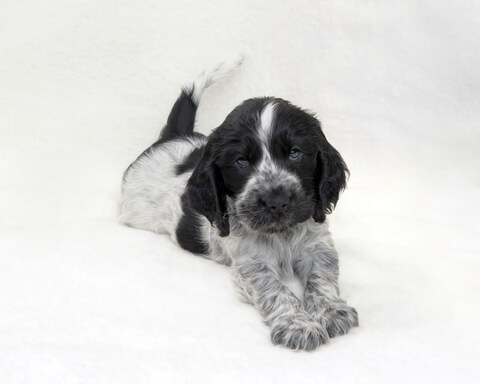 My mummy says my temperament is very loving!
My mummy says my temperament is very loving!Firstly, I strongly recommend you begin socializing your puppy when you get him home. Introduce him to new sights, sounds and situations every day until he's 12 months old.
The most effective time (and many say the only time) to socialize a puppy is when he's between 6 and 12 weeks old. Although you can continue after this, it will be less effective than it is between these two ages.
That's why it's essential to socialize your puppy as early as possible.
Secondly, I recommend training your puppy too. Some simple basic obedience commands will go a long way to giving your Cocker good manners.
A word of warning, though, if your training methods are harsh, your Cocker Spaniel won't respond very well; it will simply make him fearful. When dogs are frightened, they either become aggressive or run away; if they can't escape their situation, they will growl and bite!
I also recommend you follow the 'best practice' in this article about the alpha dog; be gentle with your sensitive little boy.
More Relevant Titles:
I'm sure you'll agree that the characteristics of a Cocker Spaniel are adorable, making this breed of dog very lovable. If you'd like to learn more about Cocker Spaniels, click on any of the links below:
Learn more about their well-being and which health problems, illnesses and diseases your Cocker Spaniel may be susceptible to.
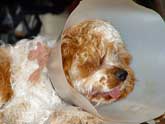
The Cocker's coat comes in some beautiful colours, including my favourite golden cockers; okay, I'm biased! Follow the link if you'd like to see more or if you'd like to learn more about the Cocker Spaniel breed in general.
Photo Credits for Cocker Spaniel Characteristics:
1. Isselee at http://www.dreamstime.com/royalty-free-stock-photos-front-view-cocker-spaniel-sitting-image12910648
2. Copyright of About Cocker Spaniels.com
3. Thearle at http://www.dreamstime.com/royalty-free-stock-photos-puppy-cocker-spaniel-blue-roan-image7837238

